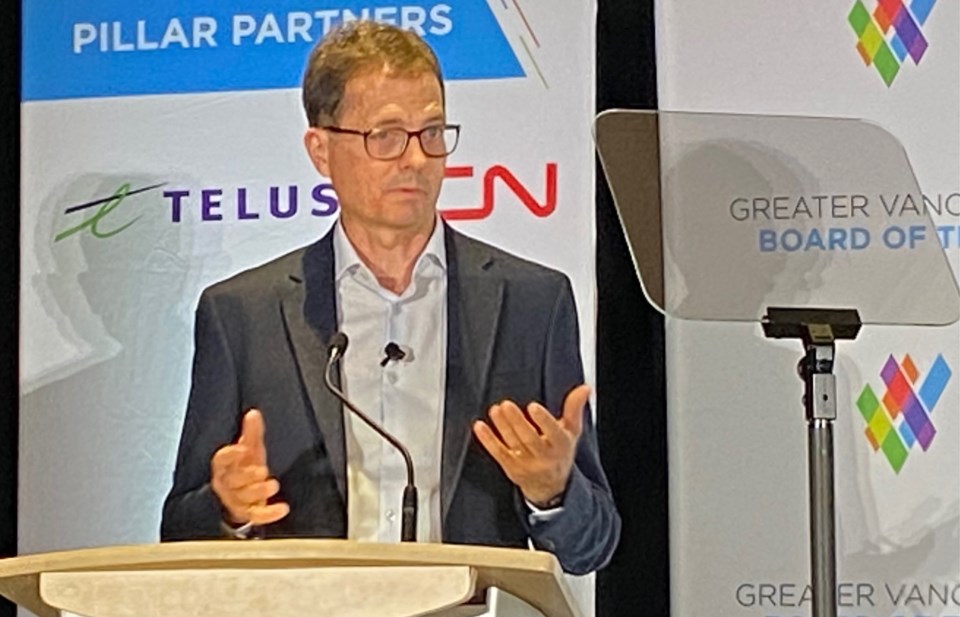Independent power producers who, with the green-lighting of Site C dam, fled B.C. a decade ago to focus on wind and solar power development in Alberta may want to turn their attention to back to B.C., now that BC Hydro has once again issued a request for clean power proposals.
Even nuclear power developers might one day get at least a hearing in B.C., BC Hydro CEO Chris O’Riley hinted at a presentation with the Greater Vancouver Board of Trade (GVBOT), though in the medium-term, most of the new power to be installed in B.C. over the next decade is most likely to be utility scale wind farms and solar plants.
BC Hydro last year had to import about 11,000 gigawatt hours (GWh) of electricity – about 20 per cent of B.C.'s power profile -- due to a drought that has lowered reservoir levels in B.C.’s hydro-electric dams.
O’Riley said BC Hydro may again import power this year, but gave assurances that it is not some “new normal.”
Drought is cyclical, he said, and by the end of this year, B.C. will have a brand new hydro-electric dam generating enough power to supply 500,000 homes with power.
“We’re importing quite a bit of power and that’s a really a common activity for us in lower water years,” O’Riley said. “This is not the first time we’ve experienced low water levels in our reservoirs. It’s not a permanent condition. We don’t see it as a trend. It’s part of a cyclical experience.”
Site C dam is 86 per cent complete, O’Riley said. He expects it will be generating power by Christmas. With a generating capacity of 1,100 megawatts (MW) – enough to power 500,000 homes – it will meet about eight per cent of B.C.’s power demand.
When Site C was greenlit, power demand was actually flat, and opponents argued it would end up an expensive white elephant, since it would produce a surplus of power that would not be needed.
And at the time, there were some sound arguments to be made that the new dam would produce a major surplus of power. Industrial power demand was in decline, due to a declining forestry sector. Pulp mills are power pigs, and several pulp mill closures meant the loss of significant industrial customers.
But a CleanBC plan with aggressive targets to electrify the economy, as well as new energy intensive industries – from mines and LNG plants to green hydrogen proposals – are expected to drive new demand for clean power.
“We’ve got unprecedented potential industrial demand across the province,” O’Riley said.
He added that electric vehicle adoption in B.C. is expected to increase from 156,000 today to 900,000 over the next decade. All of that is expected to increase the demand for more clean electricity.
As recently as 2021, BC Hydro was forecasting an electricity surplus through the 2020s in its integrated resource plan. Now it is forecasting it will need 15 per cent more power by 2032.
“It’s remarkable how times have changed,” O’Riley said in a discussion with GVBOT president Bridgitte Anderson. “It was only five minutes ago that they said ‘we’re never going to need the power from Site C.’”
When Site C comes online at the end of this year, it will have a generating capacity of 1,100 MW, or 5,100 GWh. BC Hydro recently issued a new call for power to acquire another 3,000 GWh of clean power, mostly through wind and solar, which would provide enough power to supply 270,000 homes.
“We expect to award the electricity purchase agreements by the end of this year and expect some of the projects to come online starting in the fall of 2028,” O’Riley said. “We are planning on another call…as early as 2026.”
BC Hydro is placing a couple of conditions on the new power call. It only wants larger, utility scale proposals of 40 to 200 MW, and the projects must have agreements with First Nations that provide them equity positions of at least 25 per cent.
“We are expecting to see more wind and solar come on line,” O’Riley said. “That is because the technologies have improved and the cost of those resources have come down, and that will have the benefit of adding diversity to our generation mix.”
BC Hydro plans to spend $36 billion over the next few years, with a significant amount of that investment going to transmission and distribution, including new substations in the Lower Mainland.
“With all of this investment, you may ask, ‘How are we going to keep rates affordable in our province?’” O’Riley said during his talk.
It's no mere coincidence that the three provinces in Canada with the most hydro power – Quebec, Manitoba and B.C. – have the lowest electricity rates.
O’Riley said B.C. has the second lowest residential rates in North America, and the third lowest commercial and industrial rates.
“And we are committed to ensuring our rates remain affordable while investing in our clean energy future,” he said.
Part of B.C.’s electrification plan is to extend transmission to industrial sites like mines, natural gas processing plants and LNG facilities.
Anderson asked if there might be a role for small modular reactors (SMR) in B.C. It has been suggested that SMRs would be used to power remote mine sites that are not connected to the grid, for example.
O’Riley noted nuclear power is formally banned in B.C., so the main challenge to nuclear power in B.C. is neither economic nor technical but “cultural.”
“The right work is being done in Canada and being led by Ontario,” he said. “They’re working with the federal government to get the technology approved. They’ve got some pilots that they’re going to install in Ontario.
“I think it’s a really interesting opportunity down the road, and we’d have to have a process to decide if it worked here. It’s one of those interesting opportunities for the future.”

